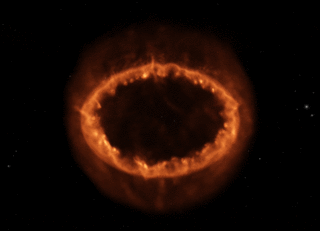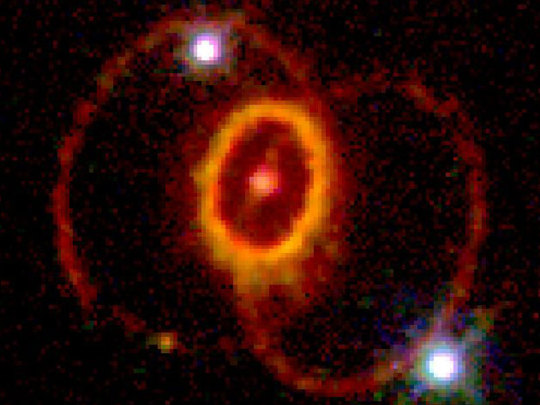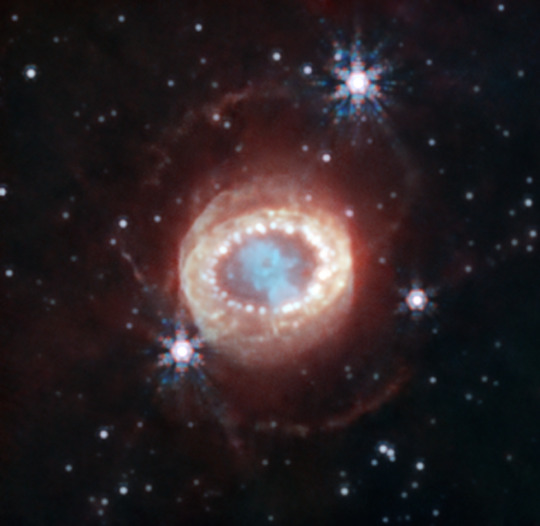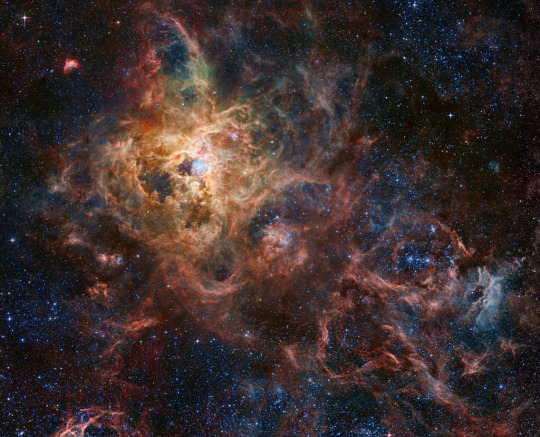#supernova 1987a
Text
Supernova 1987A's Rings of Power

Here's a Hubble photo - that's the supernova remnant embedded in the center of the image.

A Hubble close-up.
Now the Webb Space Telescope crew has released a new photo, bringing out incredible detail using the instrument's infrared camera:

The center of the remnant is packed with clumpy gas and dust ejected by the supernova explosion, first seen lighting up the Large Magellanic Cloud in February, 1987. The dust is so dense that even the near-infrared light Webb can detect can't penetrate, shaping the dark spot at the center of what looks like a keyhole.
A bright, equatorial ring surrounds all this, forming a band around the waist from material ejected tens of thousands of years before the supernova explosion. This ring contains bright hot spots that appeared as the supernova's shock wave hit the ring. Two faint arms of hourglass-shaped outer rings surround it.
Webb reveals spots throughout the ring, where supernova shocks crash into exterior material:

We'll close with NASA's animated model of Supernova 1987A's Ring of Power.
Imagine what it would be like to live on an alien world in the Large Magellanic Cloud when this beautiful monster popped off just down the street, briefly brighter than all the other stars in this companion galaxy - even brighter than our huge Milky Way Galaxy, the huge city right next door. Our potential alien neighbor can probably still see the glowing remnant in the night sky with naked eyes, decades after the star's brilliant demise. But when it exploded, it would have been visible there in broad daylight.
66 notes
·
View notes
Text
Encontraon la primera evidencia sólida de restos de estrella de neutrones de una estrella en explosión
Un equipo internacional de astrónomos, incluido el profesor Mike Barlow de la UCL (University College London), ha descubierto la primera evidencia concluyente de que existe una estrella de neutrones en el centro de la Supernova 1987A, una explosión estelar observada hace 37 años.
Las supernovas son el espectacular resultado final del colapso de estrellas con una masa entre 8 y 10 veces la del…

View On WordPress
0 notes
Text

The material around SN 1987A !
This artist’s impression of the material around a exploded star, known as Supernova 1987A (or SN 1987A), is based on observations which have for the first time revealed a three dimensional view of the distribution of the expelled material.
The observations were made by astronomers using ESO’s Very Large Telescope. The original blast was not only powerful, according to the new results. It was also more concentrated in one particular direction.
This is a strong indication that the supernova must have been very turbulent, supporting the most recent computer models.
This image shows the different elements present in SN 1987A: two outer rings, one inner ring and the deformed, innermost expelled material.
Just how a supernova explodes is not very well understood, but the way the star exploded is imprinted on this inner material. The astronomers could deduce that this material was not ejected symmetrically in all directions, but rather seems to have had a preferred direction. Besides, this direction is different to what was expected from the position of the rings.
Crédit: ESO/L. Calçada
37 notes
·
View notes
Text

Ringed Supernova
47 notes
·
View notes
Text

An article published in the journal "Science" reports new evidence that the supernova SN 1987A generated a pulsar. A team of researchers used observations conducted with the James Webb Space Telescope to detect the effects of high-energy emissions coming from the pulsar or the pulsar wind nebula, a nebula that surrounds it and is powered by the pulsar. These are confirmations of conclusions reached by other teams of researchers in recent years using observations in other electromagnetic bands.
10 notes
·
View notes
Text
2 notes
·
View notes
Text
I'm googling about supernovae for a fic and I'M SORRY BUT THERE WAS ONE FROM 1987 AND IT WAS STILL VISIBLE AS OF 2017?????
1 note
·
View note
Text
#james webb space telescope#webb space telescope#neutron star#supernova#sn 1987a#science#space#astrophysics#news#science news#space news
1 note
·
View note
Text
A star explodes: The story of supernova 1987A | Science News
In the vast canvas of our celestial sphere, where stars illuminate the tapestry of the night sky, there exists a breathtaking phenomenon that has captivated the minds of astronomers and dreamers alike. Today, we embark on a celestial journey, as we unravel the awe-inspiring tale of the supernova 1987A – an ancient star that graced our universe with its glorious explosion. In this…

View On WordPress
0 notes
Text

New Hubble Observations of Supernova 1987A Trace Shock Wave by NASA Goddard Photo and Video
1K notes
·
View notes
Photo

2023 September 7
The Large Cloud of Magellan
Image Credit & Copyright: Chris Willocks
Explanation: The 16th century Portuguese navigator Ferdinand Magellan and his crew had plenty of time to study the southern sky during the first circumnavigation of planet Earth. As a result, two fuzzy cloud-like objects easily visible to southern hemisphere skygazers are known as the Clouds of Magellan, now understood to be satellite galaxies of our much larger, spiral Milky Way galaxy. About 160,000 light-years distant in the constellation Dorado, the Large Magellanic Cloud is seen in this sharp galaxy portrait. Spanning about 15,000 light-years or so, it is the most massive of the Milky Way's satellite galaxies and is the home of the closest supernova in modern times, SN 1987A. The prominent patch above center is 30 Doradus, also known as the magnificent Tarantula Nebula, a giant star-forming region about 1,000 light-years across.
∞ Source: apod.nasa.gov/apod/ap230907.html
229 notes
·
View notes
Photo

The Mysterious Rings of Supernova 1987A
Credits: ESA, STScI, HST, NASA
28 notes
·
View notes
Text
Zoom into supernova explosion 1987A - 170,000 light years away. New Image of this supernova released by James Webb Telescope on Aug 31, 2023. Read full article here
Embark on an awe-inspiring journey with this mesmerizing video, starting with a breathtaking view of the nocturnal sky as observed from Earth. 🌌✨ As the lens zooms in, we're transported to the ethereal realm of the Large Magellanic Cloud, a satellite galaxy dancing around our Milky Way.
Prepare to be captivated as the camera delves deeper, revealing the remnants of the extraordinary supernova explosion 1987A. Nestled amidst a sea of red-hued gas, this cosmic spectacle unfolds before our eyes, showcasing the enigmatic aftermath through the lens of the Hubble Space Telescope.
Credit: NASA, ESA, and G. Bacon (STScI)

63 notes
·
View notes
Text
2024 March 8

The Tarantula Zone
Image Credit & Copyright: Processing - Robert Gendler
Data - Hubble Tarantula Treasury, European Southern Observatory, James Webb Space Telescope, Amateur Sources
Explanation: The Tarantula Nebula, also known as 30 Doradus, is more than a thousand light-years in diameter, a giant star forming region within nearby satellite galaxy the Large Magellanic Cloud. About 180 thousand light-years away, it's the largest, most violent star forming region known in the whole Local Group of galaxies. The cosmic arachnid sprawls across this magnificent view, an assembly of image data from large space- and ground-based telescopes. Within the Tarantula (NGC 2070), intense radiation, stellar winds, and supernova shocks from the central young cluster of massive stars cataloged as R136 energize the nebular glow and shape the spidery filaments. Around the Tarantula are other star forming regions with young star clusters, filaments, and blown-out bubble-shaped clouds. In fact, the frame includes the site of the closest supernova in modern times, SN 1987A, at lower right. The rich field of view spans about 2 degrees or 4 full moons in the southern constellation Dorado. But were the Tarantula Nebula closer, say 1,500 light-years distant like the Milky Way's own star forming Orion Nebula, it would take up half the sky.
#not astrology#astronomers#astronaut#astro observations#outer space#space#stars#star#constellations#constellation#black holes#astronomy#nebula#light
24 notes
·
View notes
